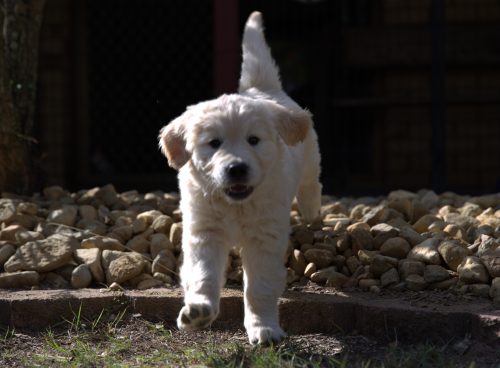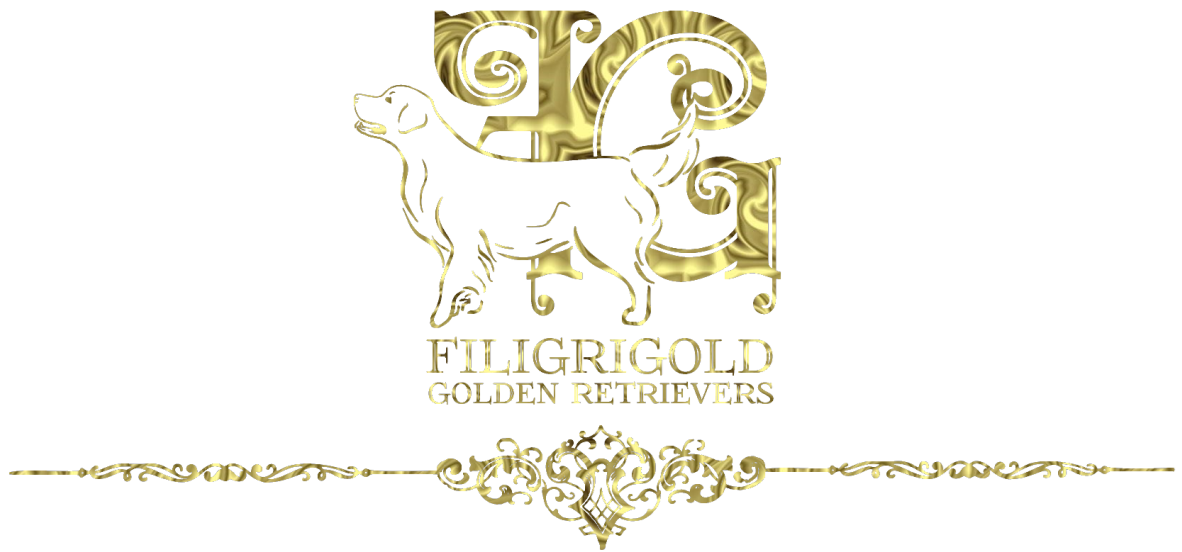HEREDITARY ISSUES
The Golden Retriever breed, in common with many other large breed dogs, can be predisposed to several health conditions which are inherited from parent to offspring. These problems include Hip Dysplasia (HD), Elbow Dysplasia (OCD), several eye diseases, and a heart condition known as Subaortic Stenosis (SAS). As preservation breeders the health of our Golden Retrievers is top priority hence all Filigrigold dogs in our breeding program being screened for these conditions, along with other DNA tests listed on the Policies page of this website.
The mode of inheritance and the specific genes involved in these diseases are yet to be fully identified. Most of these conditions have complex causes and are the result of many different contributing factors. The aberrant combination of genes which predispose the dog to the disease must be inherited and then the dog is subjected to environmental stresses which exacerbate the condition. Most of these conditions are polygenic – caused by the cumulative effects of a number of genes. Some DNA tests are now available for mutations associated with single-gene traits.
The contributing environmental factors in hip and elbow dysplasia are the dog’s weight, the amount and type of exercise, and the puppy’s growth rate. These all collaborate in the expression of the disease. Other diseases such as epilepsy are suspected to have a genetic basis, but the mode of inheritance has not been identified.
All Golden Retriever Breed Clubs recommend that no dog with a serious genetic defect should be bred from. Breeders who are members of the Golden Retriever Club of Qld. Inc. are recommended to follow the rules set down by the Club. These rules include screening of all hereditary defects by either x-rays, specialist consultations etc. before breeding with a male dog or bitch. Eye certificates must be renewed annually.
An initiative introduced by the National Golden Retriever Council is for all Golden Retrievers born after 1 January 2002 to have their Hip Grading Certificates lodged with DOGS Qld prior to the registration of litters.
PUPPY EXERCISE AND GROWTH PLATES
(Article Source: https://dogsolutions.co.za/puppy-exercise-and-growth-plates/)
Puppies: lively, active bundles of cute!
Always on the go and looking for something to do while exploring their world. Then the odd period of rest and deep sleep.
 Puppies struggle with stairs for a reason – they shouldn’t be climbing them! Please carry your puppy up and down stairs while they are young.
Puppies struggle with stairs for a reason – they shouldn’t be climbing them! Please carry your puppy up and down stairs while they are young.
Because puppies are so busy, many owners think that it’s impossible to provide too much exercise. Many think that it’s okay tire them out with exercise to the point that they no longer want to run around and play. Some peace in the house!
Most people however, don’t consider another factor – the development of the puppy’s growth plates.
People don’t consider the damage that is possible while your puppy is growing and still developing.
To work out how much exercise your puppy needs, ensuring that the growth plates develop properly and normally, it is important to know:
- what the growth plates are
- what they do and
- how they develop.
GROWTH PLATES – WHAT ARE THEY?
 The growth plates in the dog are the areas of cartilage that develop at the end of the long bones of the legs. Over time, they calcify and develop into denser matter as the puppy gets older and works their muscles more.
The growth plates in the dog are the areas of cartilage that develop at the end of the long bones of the legs. Over time, they calcify and develop into denser matter as the puppy gets older and works their muscles more.
As your puppy grows, how and when they exercise should match their development – only increasing as they grow. This happens in conjunction with the hardening process of the growth plates themselves.
Before growth plates fully develop and mature into harder bone matter, they can be extremely vulnerable to injury. Injuries to growth plates mostly occur from too much exercise and hard impacts. These are the final parts of the long bones to harden.
Injures or fractures to a leg before the growth plates have hardened, can present problems with healing. This may lead to potential developmental deformities of the leg or joint. It may even include cell damage that prevents the growth plate from fully developing, leading to a deformity of the bone.
The most common area for a problem with the growth plates to develop is in the elbow, between the ulna and radial bones of the front legs.
Damaged growth plates in this area may cause one of the bones to stop growing. But the opposite bone will continue to develop normally. This can lead to bow legs and an awkward moving gait that the puppy will have for life. Over time, this may lead to uneven pressure on the other legs, causing a range of secondary problems for the dog down the line, including early onset arthritis.

From: The Epiphyseal Plate: Physiology, Anatomy, and Trauma BYDIRSKO VON PFEIL , DR.MED.VET , DVM , DACVS , DECVS , CHARLES DECAMP , DVM , MS , DACVS
SO, HOW MUCH EXERCISE DO PUPPIES NEED?
This is a challenging question.
The goalposts are ever changing due to your puppy’s changing age and growth!
How much exercise also depends on the type of exercise that your pup receives.
 Walks on the lead are low-impact and can be carried out more often for short periods.
Walks on the lead are low-impact and can be carried out more often for short periods.
High-impact, vigorous play such as running and jumping, should be discouraged or monitored VERY carefully to avoid causing damage to the developing limbs.
This potential for damage during development is why you should never get your puppy started in any canine sports such as agility until your pup is at least a year to eighteen months old.
This is one of the rules of the sport to protect the health and growth of your developing puppy.
Pups go through their largest, fasted period of physical growth and development between the ages of four and eight months. This is when growth plates are also working their hardest to harden off.
After around eight months of age, the growth plates should be fully or almost fully fused, depending on the breed of your dog. This period is the largest window of risk of damage.
Some giant dog breeds grow and develop at a much slower rate. It can take eighteen months to two years for growth to complete and the growth plates to have fully developed.
When exercising your puppy before they reach the age where the growth plates have fully developed, it is important to factor in their age and stage of development. Increase their exercise levels as they get older – gradually!

For more information on exercising your puppy safely and puppy fitness tips that fit the age of your puppy click on the following link:
Age Appropriate Exercise for Your Puppy
Exercise examples with agility puppies: let them run straight through a “jump” with the cross bar lying on the floor. Try to avoid sharp turns at high speed. Avoid throwing a ball too much at high speed as this causes the puppy to stop hard and then turn tight to return to you, putting a lot of strain on an underdeveloped skeleton and immature muscles.
Take into account your dog’s development when working out what is best for them. Rather err on the safe side until their growth plates are closed.
Do not push them past the point of tiredness or reluctance to play because their muscles become tired and cannot help to hold and protect their skeleton. This is when injuries occur!
Remember that a half hour sedate walk is very different to a half hour of vigorous jumping and running around!
Don’t forget to give them some mental stimulation too – this is exercise too and also the most tiring form of exercise for your puppy!
*** WE ARE STILL CONSTRUCTING THIS PAGE – THANK YOU FOR YOUR PATIENCE ***

